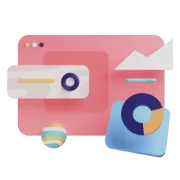How does it works?
Our team comprises proficient professionals skilled in harnessing Google Pagespeed Insights, dedicated to optimizing WordPress website performance. Leveraging cutting-edge insights and industry best practices, our experts implement tailored approaches to enhance website speed, reduce Time to First Byte (TTFB), and boost core web vitals for an improved user experience.
Drive higher RoI from your campaigns!
4 Pillars for Page Speed Enhancement
Page speed enhancement for a website can be broken down into four main pillars: Each of these pillars is interrelated, and all must be working together for a website to have optimal page speed.

Auditing: Comprehensive Assessment for Performance Enhancement
Auditing is a pivotal initial step if you are looking to improve website performance. It involves an in-depth evaluation conducted by web development experts to diagnose issues affecting page speed and user experience. The auditing process encompasses various facets such as Code Analysis, Optimize Images and Media Review, and assessing the website's hosting infrastructure and server environment. Utilizing tools like Google PageSpeed Insights, GTmetrix, or WebPageTest, experts conduct comprehensive performance tests. Specific issues such as slow page load times, oversized images, and code inefficiencies, including bloat, are identified for rectification. Finally comes insight gathering for strategic optimization. The insights help in formulating a strategic optimization plan tailored to address specific performance bottlenecks.

Optimization: Streamlining Website Efficiency
This phase starts with Image Optimization, where experts compress images while preserving quality. Resource Minification follows, streamlining HTML, CSS, and JavaScript for enhanced performance. Optimizing code structure is crucial for efficiency, involving restructuring without functional changes. Database optimization streamlines queries and removes redundancy. Strategic caching improves page loading. Finally, Prioritization and Continuous Improvement occur, ranking optimization based on impact.

Content Delivery Network (CDN): Enhancing Content Distribution and Website Performance
A Content Delivery Network (CDN) efficiently disperses website content by utilizing servers across global locations. Its core purpose is to store and deliver content from servers closest to the user's location, reducing latency. CDNs encompass multiple edge servers worldwide where content like images, videos, and scripts is cached. When a user accesses a website using a CDN, the content is delivered from the nearest server, reducing load times and enhancing user experience. By minimizing latency and improving connection times through proximity-based servers, CDNs expedite content delivery, resulting in faster website rendering and enhanced performance. This strategy significantly reduces data transfer times, ensuring swift access to website resources for users.

Server Optimization: Enhancing Server Performance for Improved Website Response
Server-side optimization focuses on fine-tuning and optimizing the server environment where a website is hosted. This phase includes a series of strategic actions aimed at maximizing server efficiency and improving website response times. It starts with the selection of faster web servers. Web development companies evaluate and select faster and more efficient web servers based on performance, reliability, and scalability. Configuration for proper caching headers comes next. Configuring the server to send appropriate caching headers is crucial for optimizing resource caching and reducing redundant data transfers. The cumulative effect of server-side optimizations significantly reduces the server load and resource consumption. As a consequence, website visitors experience faster page loading, reduced waiting times, and an overall more responsive browsing experience.
What Our Customers Are Saying
Our Clients send us a bunch of smiles with our services and we love them.
Code & Peddle process was very deliberate in their development of a strategy – which we liked. They have a system in place that makes it easy to report and track where the progress of project hours go.

The professionalism and personalized service that we got from Success Agency is unlike any other company we worked with and they made us feel so comfortable. Incredibly trustworthy and high value!!! Thank you!

Code & Peddle understanding of technical SEO and content marketing clearly differentiates them from the myriad of other SEO/SEM agencies. Their data driven approach to Social just downright works

How about scheduling a call with us to learn more?
FAQs
Page Speed refers to how fast a web page loads and displays its content. It's crucial for user experience and impacts SEO, as faster-loading pages tend to rank higher in search results.
Page Speed is measured using tools like Google PageSpeed Insights or GTmetrix. Ideal benchmarks vary, but a load time of under 2-3 seconds is often considered good for optimal user experience.
Factors affecting Page Speed include large image sizes, excessive HTTP requests, render-blocking JavaScript, heavy CSS, lack of browser caching, server response time, and the hosting platform's performance.
Image optimization involves compressing images, choosing appropriate file formats (like WebP), using responsive images, and lazy loading (loading images as users scroll) to reduce load times.
Browser caching stores website files temporarily on a user's device. Properly configuring caching headers and leveraging browser caching can significantly improve Page Speed by reducing server load and load times for returning visitors.
CDNs distribute website content across multiple servers globally, reducing latency by serving content from the nearest server to the user's location, thereby improving Page Speed.
Mobile optimization is critical for Page Speed, considering varying network speeds. Optimizations include responsive design, AMP (Accelerated Mobile Pages), and reducing unnecessary elements for mobile users.
Yes, Google considers Page Speed as a ranking factor. Faster-loading pages generally rank higher, improving user experience and SEO performance.
Regular monitoring and optimization are essential, especially after making changes or updates to a website. Continuous improvement helps maintain optimal Page Speed.
Faster Page Speed significantly influences user engagement and conversion rates. Studies show that slower load times lead to higher bounce rates, reduced user engagement, and lower conversion rates, emphasizing the importance of optimizing Page Speed for better website performance and user interactions.


















